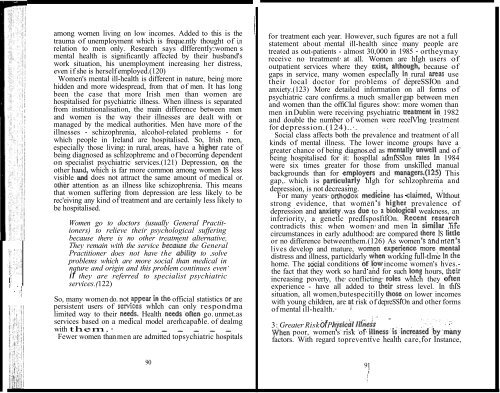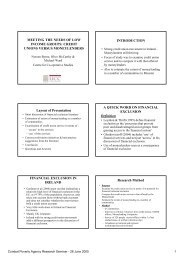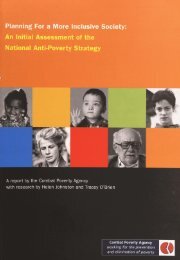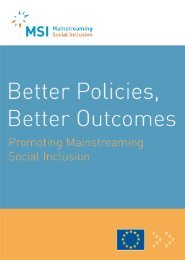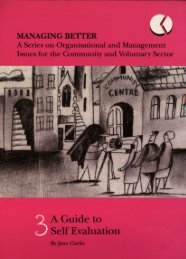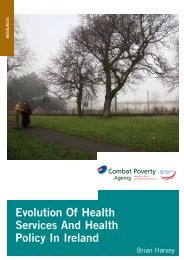Women and Poverty (1989) - Combat Poverty Agency
Women and Poverty (1989) - Combat Poverty Agency
Women and Poverty (1989) - Combat Poverty Agency
You also want an ePaper? Increase the reach of your titles
YUMPU automatically turns print PDFs into web optimized ePapers that Google loves.
first <strong>and</strong> last. This difference is crucial, both on the part of<br />
workers themselves <strong>and</strong> for the·way they are treated.<br />
<strong>Women</strong>'s family responsibilities impinge on their work in<br />
many ways. First, employed mothers can have less time<br />
available for the job - to do overtime to participate in<br />
educational courses outside of work, even'to devote the time<br />
necessary to develop social contacts <strong>and</strong> networks - so<br />
important in many jobs today. Work in the home is still<br />
mainly a woman's responsibility whether she is employed or<br />
not. Husb<strong>and</strong>s of employed women spend only about 4 more<br />
hours a week on housework than men whose wives are fulltime<br />
in the home - 16 as against 12 hours a week.(55) So, if a<br />
woman goes out to work, she usually still retains the<br />
responsibility for home <strong>and</strong> family. <strong>and</strong> the very heavy<br />
workloads associated with both. The average employed<br />
married woman in Irel<strong>and</strong> ·puts in a 70 hour week between<br />
home <strong>and</strong> job, compared with a 60 hour week on average for<br />
men.(56) The typical working week. for the woman in the<br />
home is about 68 hours.<br />
<strong>Women</strong>'s employment careers are also interrupted for childbearing<br />
<strong>and</strong> child-rearing. At best, they are out of their jobs<br />
for a few years. This may not seem alot but women are often<br />
away from their jobs during the time that is most important<br />
for career advancement, the late twenties, early thirties. So,<br />
their family responsibilities are a major· source of<br />
disadvantage to women in the workplace, given the present<br />
structure ofwork in our society. .<br />
.,<br />
<strong>Women</strong> areEmployed for Fewer Hours than Men<br />
According to the 1987 LaboUr Force Survey, women spend<br />
an average of 38 hours a week on the job while the average<br />
man works a 47 hour week. This explains some of the<br />
difference in earnings. Another factor is women's fairly high<br />
involvement in part-time work. Almost one in five women<br />
work~ works part-ti!De, ~sually paid less <strong>and</strong> in poorer<br />
conditions than full-time Jobs. <strong>Women</strong> held 78% of the<br />
96,800 part-time jobs in Irel<strong>and</strong> in 1987; In fact, this kind of<br />
work is becoming more <strong>and</strong> more important for women. In<br />
contrast, just 2% of men work in apart-time capacity, usually<br />
young <strong>and</strong> single men. Two industries predominate for part-<br />
time work: professional services (ie education, health, legal<br />
services, etc); <strong>and</strong> a group consisting of distributive trades,<br />
insurance, finance <strong>and</strong> business services.(57) Most (63%)<br />
part-time women workers are married, so it is mainly women<br />
involved in rearing families, or those who have already done<br />
so, who work on a part-time basis. Whether women work<br />
part-time by choice or not is far from certain. One thing we<br />
can be sure of: part-time work has many disadvantages that<br />
may heighten women's risk ofpoverty in the long run.<br />
.. Part-time jobs are paid at a lower rate - £1 to £2 an hour is<br />
not uncommon. Part-time workers are among the worst paid<br />
in the labour force <strong>and</strong> women part-timers earn least of all.<br />
This stems from a number of facts such as: many part-timers<br />
work in industries which are traditionally poorly paid; parttimers<br />
are mainly concentrated in manual occupations which<br />
are not defined as skilled, <strong>and</strong> they are in the lower grades;<br />
part-timers do not as a rule receive overtime payments;. their<br />
hours are often limited <strong>and</strong> rates ofpay. are not covered by<br />
legislation.(58)<br />
As well as the low earnings, the expansion of part-time<br />
work has other negative consequences. The ·low number of<br />
hours worked excludes.many workers from legislative<br />
protection. You have to work at least eighteen hours a week<br />
to. be covered for illness, redundancy, pension, maternity<br />
leave. On the basis of the Labour Force Survey .of 1987,<br />
nearly 30,000 people· worked· less than eighteen hours. a<br />
week, 23,000 of whom were women. Employers' costs are<br />
substantially reduced when workers are not covered by<br />
legislative protection:· their PRSI ,contribution is lower,<br />
among other things. So, there' is an incentive for employers<br />
to push their workers' hours below the statutory minimum:<br />
small wonder, then, that the hours'worked by part-timers are .<br />
decreasing... : !. i . '. .' '.<br />
Another disadvantage of part-time work is that it· rarely<br />
offers any opportunities· for career advancement <strong>and</strong><br />
promotion, developing new skills or training. In addition,<br />
working conditions are often very, poor in part-time jobs:<br />


